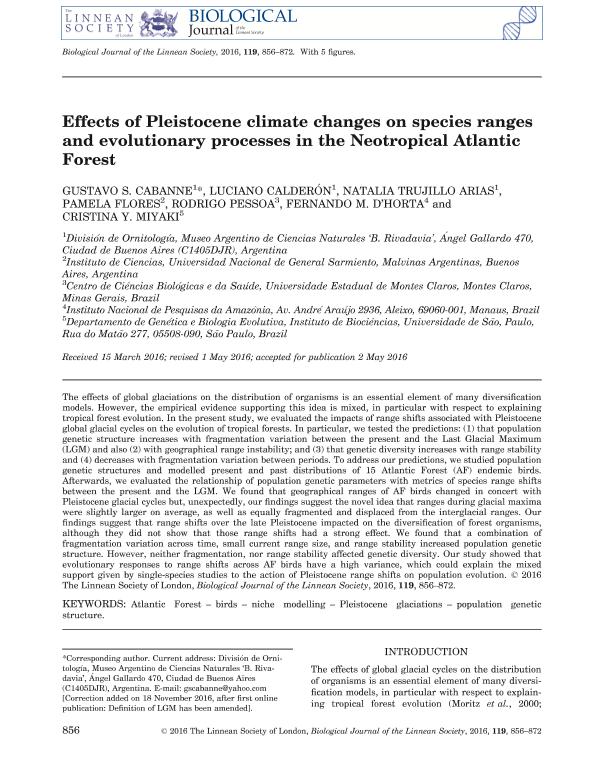Mostrar el registro sencillo del ítem
dc.contributor.author
Cabanne, Gustavo Sebastián

dc.contributor.author
Calderón, Pablo Luciano Sebastian

dc.contributor.author
Trujillo Arias, Natalia

dc.contributor.author
Flores, Andrea Pamela

dc.contributor.author
Pessoa, Rodrigo
dc.contributor.author
D´Horta, Fernando M.
dc.contributor.author
Miyaki, Cristina Yumi

dc.date.available
2020-05-18T19:51:30Z
dc.date.issued
2016-05
dc.identifier.citation
Cabanne, Gustavo Sebastián; Calderón, Pablo Luciano Sebastian; Trujillo Arias, Natalia; Flores, Andrea Pamela; Pessoa, Rodrigo; et al.; Pleistocene climate changes affected species ranges and evolutionary processes in the Atlantic Forest; Wiley Blackwell Publishing, Inc; Biological Journal of The Linnean Society; 119; 5-2016; 856-872
dc.identifier.issn
0024-4066
dc.identifier.uri
http://hdl.handle.net/11336/105390
dc.description.abstract
The effects of global glaciations on the distribution of organisms are an essential element of many diversification models. However, the empirical evidences supporting this idea are mixed, in particular to explain tropical forest evolution. In this study, we evaluated the impacts of range shifts associated to Pleistocene global glacial cycles on the evolution of tropical forests. In particular, we tested the following predictions: 1) that population genetic structure increases with fragmentation variation between the present and the LGM, and also 2) with geographic range instability; 3) that genetic diversity increases with range stability, and 4) decreases with fragmentation variation between periods. In order to address our predictions, we studied population genetic structures and modelled present and past distributions of 15 Atlantic Forest (AF) endemic birds. Afterwards, we evaluated the relationship of population genetic parameters with metrics of species range shifts between the present and the last glacial maxima. We found that geographic ranges of AF birds changed in concert with Pleistocene glacial cycles, but unexpectedly, our findings suggests the novel idea that ranges during glacial maxima were in average slightly larger, equally fragmented and displaced from the interglacial ranges. Our findings support that range shifts over the late Pleistocene impacted diversification of forest organisms, although, they did not show that those range shifts have a strong effect. We found that a combination of fragmentation variation across time, small current range size and range stability increased population genetic structure. However, neither fragmentation nor range stability affected genetic diversity. Our study showed that evolutionary response to range shifts across AF birds have a high variance, which could explain the mixed support given by single-species studies to the action of Pleistocene range shifts on population evolution.
dc.format
application/pdf
dc.language.iso
eng
dc.publisher
Wiley Blackwell Publishing, Inc

dc.rights
info:eu-repo/semantics/openAccess
dc.rights.uri
https://creativecommons.org/licenses/by-nc-sa/2.5/ar/
dc.subject
ATLANTIC FOREST
dc.subject
BIRDS
dc.subject
POPULATION GENETIC STRUCTURE
dc.subject
PLEISTOCENE GLACIATIONS
dc.subject
NICHE MODELING
dc.subject.classification
Zoología, Ornitología, Entomología, Etología

dc.subject.classification
Ciencias Biológicas

dc.subject.classification
CIENCIAS NATURALES Y EXACTAS

dc.title
Pleistocene climate changes affected species ranges and evolutionary processes in the Atlantic Forest
dc.type
info:eu-repo/semantics/article
dc.type
info:ar-repo/semantics/artículo
dc.type
info:eu-repo/semantics/publishedVersion
dc.date.updated
2020-04-28T14:35:00Z
dc.journal.volume
119
dc.journal.pagination
856-872
dc.journal.pais
Reino Unido

dc.journal.ciudad
Londres
dc.description.fil
Fil: Cabanne, Gustavo Sebastián. Consejo Nacional de Investigaciones Científicas y Técnicas. Oficina de Coordinación Administrativa Parque Centenario. Museo Argentino de Ciencias Naturales "Bernardino Rivadavia"; Argentina
dc.description.fil
Fil: Calderón, Pablo Luciano Sebastian. Consejo Nacional de Investigaciones Científicas y Técnicas. Oficina de Coordinación Administrativa Parque Centenario. Museo Argentino de Ciencias Naturales "Bernardino Rivadavia"; Argentina. Consejo Nacional de Investigaciones Científicas y Técnicas. Centro Científico Tecnológico Conicet - Mendoza. Instituto de Biología Agrícola de Mendoza. Universidad Nacional de Cuyo. Facultad de Ciencias Agrarias. Instituto de Biología Agrícola de Mendoza; Argentina
dc.description.fil
Fil: Trujillo Arias, Natalia. Consejo Nacional de Investigaciones Científicas y Técnicas. Oficina de Coordinación Administrativa Parque Centenario. Museo Argentino de Ciencias Naturales "Bernardino Rivadavia"; Argentina
dc.description.fil
Fil: Flores, Andrea Pamela. Universidad Nacional de General Sarmiento. Instituto de Ciencias. Area de Biologia y Bioinformatica.; Argentina
dc.description.fil
Fil: Pessoa, Rodrigo. Universidade Estadual de Montes Claros; Brasil
dc.description.fil
Fil: D´Horta, Fernando M.. Instituto Nacional de Pesquisas da Amazonia; Brasil
dc.description.fil
Fil: Miyaki, Cristina Yumi. Universidade de Sao Paulo; Brasil
dc.journal.title
Biological Journal of The Linnean Society

dc.relation.alternativeid
info:eu-repo/semantics/altIdentifier/doi/http://dx.doi.org/10.1111/bij.12844
dc.relation.alternativeid
info:eu-repo/semantics/altIdentifier/url/https://onlinelibrary.wiley.com/doi/abs/10.1111/bij.12844
Archivos asociados
